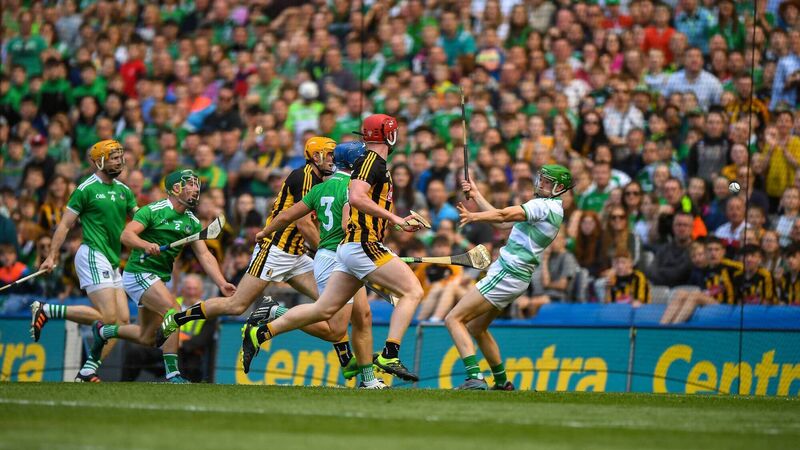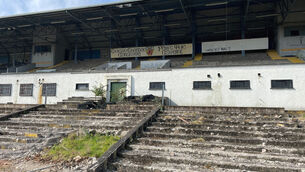Enda McEvoy: Have Kilkenny found a philosophy to end their goal drought?

Kilkenny’s Colin Fennelly scores his side’s first goal during the All-Ireland Senior semi-final against Limerick at Croke Park. Kilkenny could do with a return to that kind of form. Picture: Sportsfile
Here’s something to look out for at Croke Park this afternoon, whether you’re watching on GAAGo or on the wireless or on Twitter or indeed are not watching the first — and patently less interesting — of the two Leinster semi-finals at all.
How many goals will Kilkenny score?
Let’s rephrase that. In view of the blanks they’ve been firing on their recent visits to HQ, will the men in stripes score a goal at all? And which or whether, how many goal chances will they create?
If the answers to these questions fall into the category of None/One/Very Few, the inference will be inescapable, regardless of the result of the match. Kilkenny can be struck off the list of serious MacCarthy Cup contenders.
They used to have goal scorers and they used to score goals. Lots of them. Goals in the opening ten minutes; goals in the closing ten minutes; goals just before half-time; goals just after half-time. Quite often they scored them in rapid-fire pairs with the signature double tap of the professional assassin. One to the chest, one to the head. No open casket for the unfortunate victim.
These days they score points. All well and good, but man cannot live by points alone. Not in this day and age. Not when Kiely’s Limerick and Sheedy’s Tipperary are around. Where Cody’s late noughties Kilkenny carried more weaponry than Keanu Reeves and yer woman in The Matrix, his late-2010s Kilkenny had a habit of making the opposition look as defensively impregnable as the Milan clubs at catenaccio’s dismal apogee. No bullet time here. No bullets, even.
No goal in last year’s All-Ireland final. No goal in the Leinster final. One goal in that non-relegation playoff against Cork — or is the latter merely a rumour, given that the fixture in question was attended by about 13 spectators and two dogs? If a goal is scored in Nowlan Park but nobody is there to see it, does it make a sound? Is it still a goal?
The contrast with the neighbours could scarcely be more striking. Tipperary’s attacking play takes the form of a course module authored by a man who revered Johan Cruyff and who waxes lyrical about esoterica like connectivity and the sound the sliotar makes when struck.
Kilkenny’s attacking play, as if to prove that everything comes back into fashion if you wait long enough, is straight outta 2003-04: shag the ball down the field as hard as you can and let the Ballyhale man take it from there.
Had Tipp been reduced to 14 men for the second half of the All-Ireland final they’d have coped. They might even have flourished, as they had against Wexford. What’s a certainty is that they’d have imagined their way around the field and played their way up it, trellising their passes together, sculpting their deliveries at the right height and optimum angle for the receiver, who in his turn would have floated out into space to make himself available.
It’s the kind of thing that happens when a team has an attacking philosophy with an intellectual underpinning it, as Eamon O’Shea’s Tipperary do. Kilkenny’s lumpenness after Richie Hogan’s dismissal is the kind of thing that happens when a team doesn’t have an attacking philosophy and is not overly interested in trying to intellectualise one.
Spirit may equip a team with the desire and determination to attack the enemy’s castle; it doesn’t necessarily furnish them with the heavy ordnance to knock down the ramparts or the lateral thinking to go about hopping in over the wall.
But hush, what have we here? Hmmm —a 2020 Kilkenny management team that features not one but two notable green flag merchants. Goodness.
The first is DJ Carey, that creation of the gods who knew exactly what he was doing every time he switched on the afterburners and headed for the opposition posts. In the process he ended up scoring some of the most unforgettable goals ever scored and he scored them over and over again.
The other is Martin Comerford, not quite a creation of the gods and a chap who rarely seemed to know what he was doing every time he settled into his Bambi stride and headed for the opposition posts. In the process he ended up scoring the goals that won two All-Irelands finals.
It is asking much of former players to coach others in what came so naturally and intuitively, even inexplicably, to themselves. Yet Colin Fennelly, who was in the form of his career during the local championship, can only do so much operating with his back to goal.
Due to his myriad abilities and consequently myriad functions in recent years (puckout winner, creator, point-scorer, freetaker, even occasional midfield fireman), moreover, TJ Reid has been deployed at a sufficient distance from goal to gladden the hearts of opposition defenders.
Bottom line, Kilkenny will not win an All-Ireland until they start scoring goals again. They won’t start scoring goals again until their forwards coaching is more enlightened and imaginative. This is not a vicious circle.
Their clashes with Dublin of late have run along familiar rails. The underdogs make the running for 30 minutes or 45 minutes or, as was the case at Parnell Park two years ago, 60 minutes. Thereupon enough of the roof falls in for Kilkenny to emerge from the rubble.
Neither side, nor the contestants in the other semi-final, will have missed the lesson from Semple Stadium last Sunday. In an environment where everyone can break the 20-point barrier almost as an afterthought, the serious teams in this championship will set themselves apart by adding goals.
It’s all well and good for Limerick, who drew a line in the sand that few teams will approach. Even Tipperary, with their battalion of long-range assassins, will require goals tomorrow unless Kiely’s men endure a horror show with their shooting from out the field. Limerick can — and will be happy to — win the All-Ireland by staying in the centre of the ring and using their jab to keep opponents at a safe distance, eschewing the option of getting in close and hammering away with body shots.
As long as the ground remains firm a tally in the low 20s will not cut the mustard on any given day; the other crowd will be hitting as much themselves. So when everyone else is busy drilling points from 60 metres, who’ll be the forwards with the nerve to make the runs, fashion the chances and be prepared to take the punishment?
Under Micheál Donohoe, the Galway attackers were, like Limerick, content to hurl from outside their men. It’ll be instructive to see what tweaks Shane O’Neill — so successful at Na Piarsaigh, where in a dressing room full of strong characters there was only one boss — will choose to make to their game. That Galway may be reaching the end of a cycle is not to say that a couple of judicious nips and tucks won’t help refresh and retread them, to auspicious short-term effect.
Themselves or Wexford this evening? Toss a coin.
Last week’s fare was the equivalent of an action movie where the camera never rests but nobody gets hurt. It’ll take another weekend or two for the pitches to get heavy and the scoring rate to regress to the mean. A goal, however, is still worth three points.

Unlimited access. Half the price.
Try unlimited access from only €1.50 a week
Already a subscriber? Sign in







